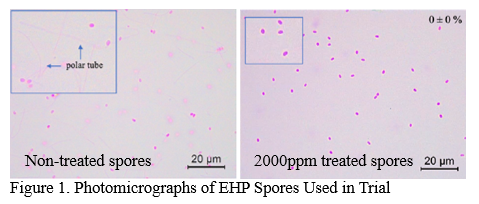EFFECT OF OREGANO ESSENTIAL OIL AND QUILLAJA SAPONIN EXTRACT ON THE POLAR TUBE EXTRUSION ACTIVITY OF SHRIMP MICROSPORIDIAN Enterocytozoon hepatopenasei
Introduction
Oregano essential oil (OEO) has been widely shown to support the health and productivity of various production species. Orego-Stim Forte (Anpario plc) is a commercial additive containing OEO and Quillaja saponaria extract. The trial objective was to determine whether this feed ingredient can inhibit the polar tube extrusion of Enterocytozoon hepatopenasei (EHP) spores that infect shrimp and cause significant economic losses to production.
Materials and Methods
The study consisted of two phases. Phase one aimed to determine the inhibitory effect of the test ingredient on the polar tube extrusion activity of EHP spores. Concentrations ranged from 500 to 4000ppm with 30 minute contact time. For phase two, the infectivity of ingredient-treated EHP spores was tested following oral intubation of live shrimp. The SWP-qPCR method of hepatopancreas samples was used to determine the EHP replication levels of those spores fed orally to shrimp after 9-10 days.
Results
For both low and high-salinity sourced EHP spores, no polar tube extrusion was detected when exposed to ≥2000ppm of the test ingredient (Figure 1).
Second phase results were collected following oral intubation of shrimp with ingredient-treated EHP spores from the first phase of the trial. SWP-qPCR of hepatopancreas samples revealed no infectivity of treated EHP spores when exposed to ≥2000ppm and ≥1000ppm concentrations from low and high salinity sources respectively.
Summary
The test ingredient at ≥2,000ppm, containing OEO and quillaja saponin extract, inhibited polar tube extrusion of EHP spores in-vitro. Oral inoculation of treated spores at ≥2,000ppm confirmed inactivity since no replication was detected following SWP-qPCR of shrimp hepatopancreas samples 9-10 days post-injection.
